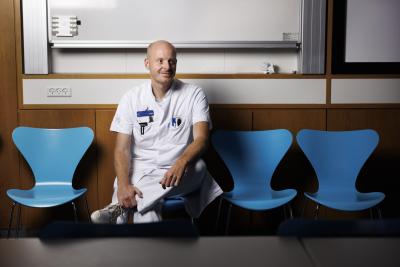Emil Fosbøl
This year’s prize goes to a man specialising in heart valves
Emil Loldrup Fosbøl, Senior Consultant of Cardiology at Rigshospitalet, University of Copenhagen, is receiving the 2021 Lundbeck Foundation Young Investigator Prize. The prize is in reward for his highly talented research on valvular heart diseases.
Just as accidents can occur in clusters, positive and auspicious events sometimes appear in droves.
This is something, Emil Loldrup Fosbøl, Senior Consultant of Cardiology at the Department of Cardiology and head of the Department of Valvular Heart Diseases at Rigshospitalet, University of Copenhagen, if anyone, can confirm.

This spring, he received one of the five Elite Research Prizes (ElitForsk) awarded by the Danish government each year to young and particularly talented researchers.
The prize donates DKK 1 million (approximately EUR 0.13 million) to scientific studies and DKK 200,000 (approximately EUR 27,000) to the prizewinner in personal recognition of their work. And Fosbøl is now being showered with even more honour and monetary gain as the recipient of the 2021 Lundbeck Foundation Young Investigator Prize.
This prize is worth DKK 1 million, DKK 300,000 of which is a personal award. The rest is earmarked for research.
Although the honour is the shiniest bauble on the tree – and the money is not to be sniffed at – the most important aspect is what the man has achieved. Here is a brief summary of his accomplishments:
Since he qualified as a doctor – and at the same time submitted his PhD thesis – in 2009, Emil Loldrup Fosbøl has worked so diligently and with such talent on his research into valvular heart diseases that he is today an internationally renowned expert in the field.
He specialises, in particular, in endocarditis, which is the medical term for inflammation of the cardiac valves and the heart itself.
He is both a medical practitioner and a researcher at Rigshospitalet, University of Copenhagen, and his research focuses on cardiac epidemiology.
Among other things, he is seeking to identify how endocarditis develops in patients as well as which biological, genetic and lifestyle conditions, more specifically, appear to influence this and other heart diseases.
There’s an ever-growing need for new knowledge and better therapeutics for valvular heart disorders.
‘Endocarditis is a tricky disease to treat, and it’s also difficult to diagnose’ Fosbøl explains.
‘Luckily, it’s relatively rare. We see around 600–650 cases a year in Denmark, and two in three patients are men. But the incidence of endocarditis has been on the increase over the past 20 years, partly because average life expectancy is on the rise – and because we implant more artificial heart valves than before. That’s why there’s an ever-growing need for new knowledge and better therapeutics for valvular heart disorders.’
A new valve
But how dangerous is endocarditis, actually?
Around a third of the 600–650 patients – who have an average age of 70 – diagnosed in Denmark each year die within 12 months.
‘But it’s important to remember that the patients who end up dying from the disease often have other serious disorders,’ says Fosbøl. He describes a typical patient with infective endocarditis as being male and in their late sixties. He may have recently undergone surgery, for instance for prostate cancer, and following surgery his heart works less than satisfactorily.
He is therefore examined based on sophisticated ultrasound scans, and the doctors ascertain that he has an inflamed cardiac valve. And Fosbøl explains that, in all probability, the infection emerged during the prostate surgery.
‘This is when the infective bacteria – which are very similar to the bacteria we see in meningitis – in some way or other enter his bloodstream and, ultimately, settle on the heart valve.’
However, although a prior operation – for instance, to implant a pacemaker or artificial heart valve – is often the cause of the bacterial infection that induces endocarditis, infection can come from many other sources. It may spread after dental treatment or from wounds, urinary tract infections or cancerous tumours in the colon. And once these bacteria have settled in the heart – either in a valve or in the muscle, or both – they begin to break down tissue.
Doctors will typically attempt to cure infections with antibiotics, and this is also the case with endocarditis. If this does not succeed, they will be forced to replace the malfunctioning valve with a new one – either of metal or a biological material.
This is necessary in 20–25% of all patients with infective endocarditis because the bacteria that have attacked the patient’s heart valve cunningly barricade themselves in: either behind a biofilm – a mucous-like layer impenetrable by antibiotics – or by creating a kind of abscess on the heart valve or heart muscle from where the bacteria can cause havoc without being disturbed.
‘In such situations, there’s only one option – so-called open-heart surgery. And this requires a general anaesthetic,’ says Fosbøl.
‘The surgeons open the patient’s chest, remove the diseased valve and the part of the cardiac muscle that is damaged and then implant the artificial valve. Unfortunately, though, there are some patients who aren’t healthy enough to undergo surgery of this kind.’
And Emil Loldrup Fosbøl explains that endocarditis mortality is high in these patients.
Delving into the records
If you want to map the traits of an illness in order to gain a better understanding of it and come up with good ideas for improvements to diagnosis and treatment of the illness, you will need to study immense volumes of patient data.
‘When it comes to large volumes of patient data, Denmark is in a unique situation. All data are stored in public health registers, and researchers can gain access to these under special conditions,’ says Fosbøl.
‘And we’re tapping into one of these sources of information. But our research into valvular heart disease also involves patient trials to acquire new knowledge, and we’ve recently launched one of these trials.’
Its aim is to create a research-based basis for assessing the type of treatment that would benefit an endocarditis patient most, and for making assessment much more precise than it is today.
‘The participants in the trial – all of whom are endocarditis patients – were selected by lot and will be offered either valvular heart surgery or treatment with antibiotics. We’ll examine a total of 500 patients. They’re all currently in a kind of diagnostic “grey zone”, which means that we can’t say to them with any certainty, “You’ll probably benefit from surgery”, or “Antibiotics will probably be the solution you’ll benefit from most”. This uncertainty currently applies to a great many of the endocarditis patients we meet.’
Emil Loldrup Fosbøl stresses that participation in the trial is, of course, voluntary:
‘But the first candidates have already signed up, and in the course of a few years we expect to reach the total of 500 courses of treatment that will hopefully enable us to draw scientifically sound conclusions for the benefit of patients.’
